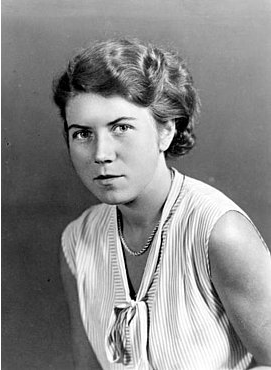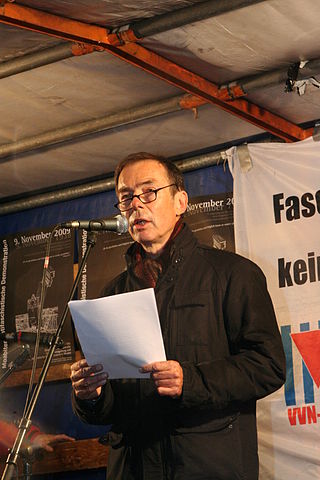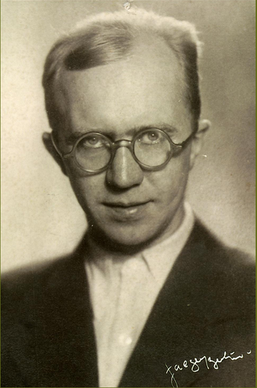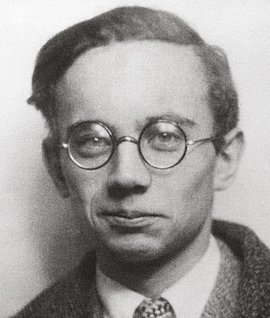
The Red Orchestra, as it was known in Germany, was the name given by the Abwehr Section III.F to anti-Nazi resistance workers in August 1941. It primarily referred to a loose network of resistance groups, connected through personal contacts, uniting hundreds of opponents of the Nazi regime. These included groups of friends who held discussions that were centred on Harro Schulze-Boysen, Adam Kuckhoff and Arvid Harnack in Berlin, alongside many others. They printed and distributed prohibited leaflets, posters, and stickers, hoping to incite civil disobedience. They aided Jews and resistance to escape the regime, documented the atrocities of the Nazis, and transmitted military intelligence to the Allies. Contrary to legend, the Red Orchestra was neither directed by Soviet communists nor under a single leadership. It was a network of groups and individuals, often operating independently. To date, about 400 members are known by name.

Wilhelm Guddorf was a Belgian journalist, anti-Nazi and resistance fighter against the Third Reich. Guddorf was a leading member of a Berlin anti-fascist resistance group that was later called the Red Orchestra by the Abwehr. Guddorf was the editor of the Marxist-Communist Die Rote Fahne newspaper.

Hans-Wedigo Robert Coppi was a German resistance fighter against the Nazis. He was a member of a Berlin-based anti-fascist resistance group that was later called the Red Orchestra by the Gestapo.

Heinz Harro Max Wilhelm Georg Schulze-Boysen was a left-wing German publicist and Luftwaffe officer during World War II. As a young man, Schulze-Boysen grew up in prosperous family with two siblings, with an extended family who were aristocrats. After spending his early schooling at the Heinrich-von-Kleist Gymnasium and his summers in Sweden, he part completed a political science course at the University of Freiburg, before moving to Berlin on November 1929, to study law at the Humboldt University of Berlin. At Humboldt he became an anti-Nazi. After a visit to France in 1931, he moved to the political left. When he returned, he became a publicist on the "Der Gegner", a left-leaning political magazine. In May 1932, he took control of the magazine, renamed as the "Gegner" but it was closed by the Gestapo in February 1933.

Libertas "Libs" Schulze-Boysen, born Libertas Viktoria Haas-Heye was a German Prussian noblewoman, who became a resistance fighter against the Nazis. From the early 1930s to 1940, Schulze-Boysen attempted to build a literary career, first as a press officer and later as a writer and journalist. Initially sympathetic to the Nazis, she changed her mind after meeting and marrying Luftwaffe officer Harro Schulze-Boysen. As an aristocrat, Schulze-Boysen had contact with many different people in different strata of German society. Starting in 1935, she utilized her position to recruit left-leaning Germans into discussion groups which she hosted at her and Harro's apartment, where they sought to influence her guests. Through these discussions, resistance to the Nazi regime grew, and by 1936, she and Harro began to actively resist the Nazis. During the early 1940s, whilst working as a censor for the German Documentary Film Institute, Schulze-Boysen began to document atrocities committed by the Nazis from photographs of war crimes forwarded by soldiers of the Sonderbehandlungen task force to the Film Institute.

Elisabeth Schumacher was a German artist, photographer. and resistance fighter against the Nazi regime. She was a member of the Berlin-based anti-fascist resistance group that was later called the Red Orchestra by the Abwehr, during the Third Reich. Schumacher trained as an artist, but as her father was Jewish, who died in battlefield during World War I, she was classified as half-Jewish or Mischling, so worked as a graphic artist, before joining the resistance efforts.

Maria "Mimi" Terwiel was a German resistance fighter against the Nazi regime. She was active in a group in Berlin that wrote and distributed anti-Nazi and anti-war appeals. As part of what they conceived as a broader action against a collection of anti-fascist resistance groups in Germany and occupied Europe that the Abwehr called the Red Orchestra, in September 1942 the Gestapo arrested Terwiel along with her fiancée Helmut Himpel. Among the leaflets and pamphlets they had copied and distributed for the group were the July and August 1941 sermons of Clemens August Graf von Galen which denounced the regime's Aktion T4 programme of involuntary euthanasia.
The Geschwister-Scholl-Preis is a literary prize which is awarded annually by the Bavarian chapter of the Börsenverein des Deutschen Buchhandels and the city of Munich. Every year, a book is honoured, which "shows intellectual independence and supports civil freedom, moral, intellectual and aesthetic courage and that gives an important impulse to the present awareness of responsibility".

Elisabeth "Elisa" Charlotte Constanzia von der Recke was a Baltic German writer and poet.

Hans Coppi Jr. is a German historian. His parents, Hilde and Hans Coppi, were active in the German Resistance and were both executed by the Nazis.

Günther Weisenborn was a German writer and fighter in the German Resistance against Nazism. He was notable for collaborating with Bertolt Brecht, along with Hanns Eisler, Slatan Dudow, on the play, The Mother. However, in 1933, when the work fell out of favour by the Nazis after being blacklisted by Joseph Goebbels, he emigrated to Argentina. When he returned in 1937, be became a member of a Berlin-based, resistance group that was later renamed to the Red Orchestra by the Abwehr. He was arrested in 1942 and sentenced to several years in prison, he was released in 1945 by Soviet troops.

Margaretha "Greta" Kuckhoff was a Resistance member in Nazi Germany, who belonged to the Communist Party of Germany and the NKVD spy ring that was dubbed the Red Orchestra by the Abwehr. She was married to Adam Kuckhoff, who was executed by the Third Reich. After the war, she lived in the German Democratic Republic, where she was president of Deutsche Notenbank from 1950 to 1958.

Gerhard Zwerenz was a German writer and politician. From 1994 until 1998 he was a member of the Bundestag for the Party of Democratic Socialism (PDS).
Gisela von Pöllnitz was a German journalist, communist, and resistance fighter against the Nazi regime. During the Nazi regime, she was a notable member of the Berlin-based anti-fascist resistance group around Harro Schulze-Boysen, later called the Red Orchestra by the Abwehr. Throughout her life von Pöllnitz had a lung condition that progressively worsened after being arrested several times by the Gestapo. On her final arrest by the Gestapo she contracted tuberculosis after 5 months in custody. Her physician Elfriede Paul arranged a sanitarium in Switzerland, but she never recovered.
Sonderkommando Rote Kapelle was a German special commission that was created by German High Command in November 1942, in response to the capture of two leading members of a Soviet espionage group that operated in Europe, that was called the Red Orchestra by the Abwehr. The Sonderkommando Rote Kapelle was an internal counter-intelligence operation run by the Abwehr and the Gestapo. It consisted of a small independent Gestapo unit that was commanded by SS-Obersturmbannführer Friedrich Panzinger and its chief investigator was Gestapo officer Karl Giering. Its remit was to discover and arrest members of the Red Orchestra in Germany, Belgium, France, Netherlands, Switzerland and Italy during World War II.

Erwin Gehrts was a German conservative socialist, resistance fighter against the Nazi regime, journalist and colonel in the Luftwaffe. Trained as a teacher, Gehrts was conscripted as a flying officer during World War I. During the interwar period, he became a journalist. However, with the emergence of the Nazi states, his newspaper, the Tägliche Rundschau, was banned. Finding work with the Luftwaffe, he became disillusioned with the Nazis. He became associated with a Berlin-based anti-fascist resistance group that was later called the Red Orchestra by the Abwehr and an informer to Harro Shulze-Boysen, passing secrets from the air ministry.
Elly Lotte Bergtel-Schleif, née Schleif, was a German librarian who was actively involved in the resistance against Nazis while a member of the Communist Party of Germany (KPD). Bergtel-Schleif became head of the Berlin Library School after the war.

Herbert Enke Wilhelm Engelsing was a right-wing German Catholic lawyer in Berlin and resistance fighter against the Nazi regime. When the Nazi regime began, Engelsing found himself unable to work in law. Instead he found work in the German film industry, becoming a very successful film producer with Tobis Film. In 1938, Engelsing and his wife Ingeborg became close friends with Libertas and Harro Schulze-Boysen who were part of a resistance organisation against the Nazis. Engelsing maintained a high profile in the film business and low profile in the resistance, but made his mark by introducing many new people into the organisation, brokering deals and providing secure locations for meetings. The couple survived the war and moved to the United States in 1947. Engelsing did not receive permanent residency due to false accusations of being the head of a Soviet sleeper cell.

Walter Husemann was a German communist and resistance fighter against the Nazi regime. As a young man, Husemann trained an industrial toolmaker, before training as a journalist. He became interested in politics and joined the Communist Party of Germany (KPD). With the arrival of the Nazis in 1933, he became a resistance fighter and through his wife, the actor Marta Husemann, he became associated with an anti-fascist resistance group around Harro Schulze-Boysen and Arvid Harnack that was later called the Red Orchestra by the Gestapo. Along with John Sieg whom he met in the KPD and Fritz Lange, Martin Weise and Herbert Grasse he wrote and published the resistance magazine, The Internal Front Die Innere Front.

Heinz Strelow was a German journalist, soldier and resistance fighter against the Nazi regime.
















